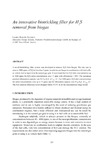An innovative biotrickling filter for H2S removal from biogas

Ver/Abrir
Use este enlace para citar
http://hdl.handle.net/2183/12814Colecciones
Metadatos
Mostrar el registro completo del ítemTítulo
An innovative biotrickling filter for H2S removal from biogasAutor(es)
Fecha
2007Cita bibliográfica
Biotechniques for Air Pollution Control II, 2007: 215-224. ISBN: 978-84-9749-258-4
Resumen
[Abstract] A novel biotrickling filter system was developed to remove H2S from biogas. The aim was to remove 2000 ppmv of H2S to less than 3 ppmv in order to use biogas in combination with fuel cells, as vehicle fuel or inject it in the natural gas grid. It was found that for H2S inlet concentrations up to 1000 ppmv the H2S outlet concentration was < 3 ppm with efficiencies > 99%. The maximum practical elimination capacity was 32.5 g-H2S. m-3 filter. h-1. For 2000 ppmv H2S inlet concentrations the outlet concentrations were up to 75 ppmv and the elimination capacity was 55 g-H2S. m-3 filter. h-1. The H2S removal efficiency never dropped below 93.5% in all the concentration range tested.
ISBN
978-84-9749-258-4





